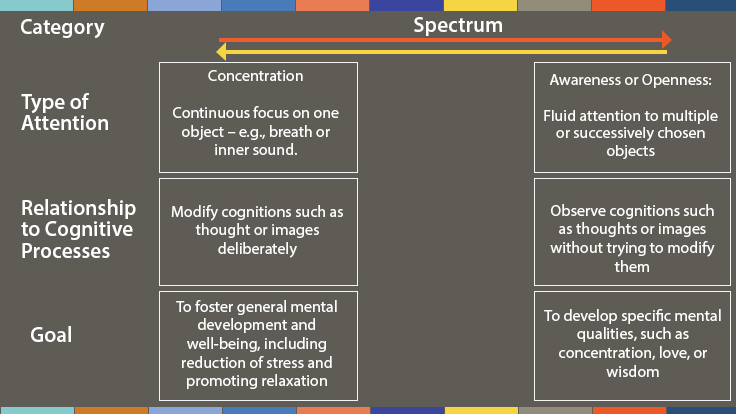One definition of “meditation” focuses on “meditation” as a “training process” that fosters mental well-being and the development of specific mental capacities. From this perspective, meditation is a process that develops self-regulation.
According to Walsh and Shapiro:
“Meditation” refers to a family of self-regulation practices that focus on training attention and awareness to bring mental processes under greater voluntary control and foster general mental well-being and development and specific capacities such as calm, clarity, and concentration.
Embodied in this definition is the call to meditation.
So, what’s that “call?”
To take an inner journey to foster general mental well-being and develop specific capacities such as calm, clarity, and concentration.
I use Walsh and Shapiro’s definition to categorize various approaches to meditation. See Figure 1.

Source: Jerome S. Paige & Associates, LLC adapted from Walsh and Shapiro.
1Roger Walsh and Shapiro Shapiro. “The Meeting of Meditative Discipleins and Western Psychology; A Mutually Enriching Dialogue.” American Psychologist, 2006. https://drive.google.com/file/d/1v0VMlfBGF68N4X8S4h-zViCwNAZL_fwu/view?usp=sharing
For example, different methods focus on how we direct our attention, relate to our thoughts, and set our practice goals.
Let’s look at “attention” in Figure 1. Here meditation can take several forms:
- Training our attention by continuously focusing on one object, like the breath or a mantra.
- Letting our attention flow to all sensations that may come up during your meditation session.
- Controlling or modifying thoughts; or just observing them without trying to change them.
- Focusing on general mental development or mental qualities, e.g., concentration on love or wisdom.
Meditation: A Way Of Knowing, Being, and Acting2
Why do we want to bring our mental and physical processes under greater and greater control?
To gain insights into how our behaviors (actions) are mere responses comprised of a combination of physical sensations and mental “interpretations” of those sensations.
With enhanced capacities to observe, we begin to modify both actions. Actions like:
- Our responses to the events of life that “trigger” us.
- Our interpretations of and relationship to what “triggers” us change.
Through meditation, we gain insight into the relationship between “events” and our “reactions to them.”
As our knowledge of this relationship deepens, it’s easier for us to develop skills like listening, being non-judgmental, and providing effective feedback.
One of meditation’s prevalent and significant uses is to reduce “stress.” My focus, however, is on “meditation” as a way of knowing, Being, and action.
Incidentally, if we start with meditation as a “stress reduction technique,” we may approach meditation as a way of knowing and being.
Alternatively, using meditation as a way of knowing, Being, and action may lead us to “relaxation.”
Once we start our internal journey, we’ll naturally move from one end of the spectrum in Figure 1 to the other and back and forth.
What To Look For In An Approach To Meditation
Given the above definitions of meditation, there’re many claimed benefits. Therefore, before taking a meditation journey, it’s helpful to decide what type of journey we want to take and what meditation approach we would like to use.
According to Shenzen Young3, a helpful meditation practice provides:
- a goal
- an object
- a path
- a technique
Yoga Nidra is one meditation I teach and practice. It offers a model to take that journey within. So, take that journey with me.
2Getting to Know the Mind: Here’s an adage: The mind creates thoughts just as the blood pumps blood. All parts of our body have functions. By practicing meditation, we get to examine what the mind does. Another metaphor: We use meditation to keep our concentration muscles strong and flexible. We consciously do sit-ups to strengthen our abs so we can call upon them in daily activities. Likewise, we deliberately rotate our consciousness so that we can call upon our Awareness in everyday activities.
3See Young’s audio course on “The Science of Enlightenment.” Also, Young’s book: “The Science of Enlightenment, How Meditation Works.” Boulder, CO., 2016.
Related Blogs
On Dissipating Discomfort With Being
On Time: Experiencing Time, Timelessness and Timeless Time
Related Meditations Recordings
Read. Like. Listen and Share.
If you are enjoying this content please consider making a contribution to the…

